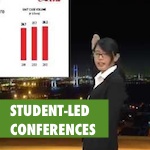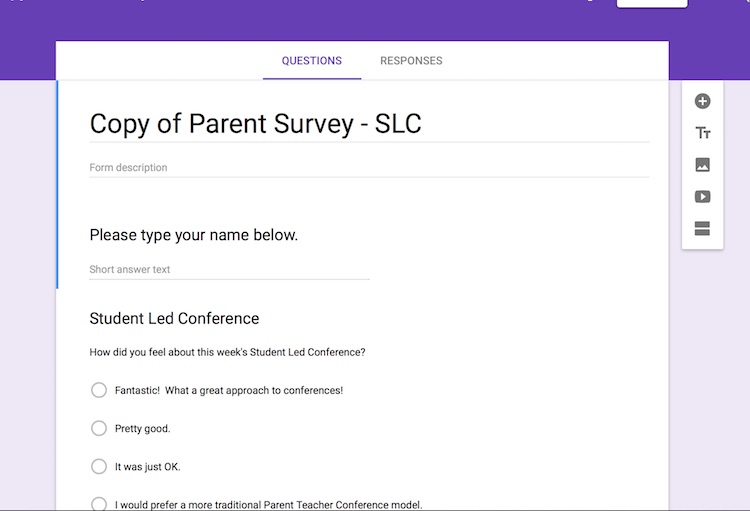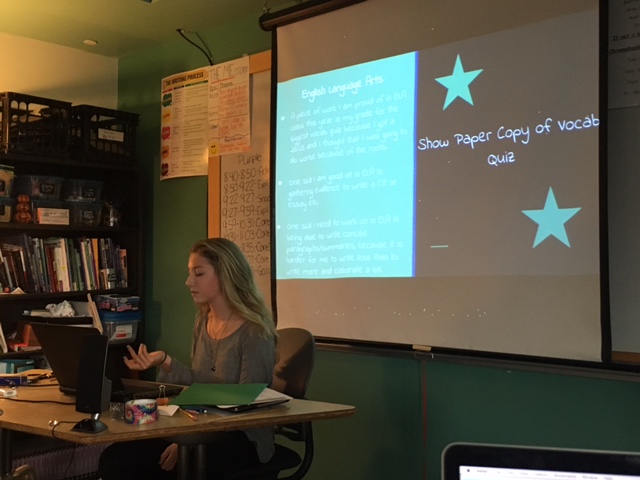Feedback, feedback, feedback!
 As educators, it’s absolutely critical that we reflect on our practices, especially new ones. As schools around the state finish with parent-teacher conferences this fall, I’d like to take a look at how to evaluate student-led conferences in particular, by checking in on how one school built feedback metrics into the process from the start.
As educators, it’s absolutely critical that we reflect on our practices, especially new ones. As schools around the state finish with parent-teacher conferences this fall, I’d like to take a look at how to evaluate student-led conferences in particular, by checking in on how one school built feedback metrics into the process from the start.
As Emeril Lagasse would say: BAMS!
Let’s look at how Brattleboro Area Middle School (BAMS) implemented their first ever student led conferences. For a school of 340 7th and 8th graders, that is no small feat. This took months of planning, preparation and learning for the teachers and students in this building.
Let’s look at how they built evaluation metrics into the process.
Ask for feedback up front

There was a friendly and welcoming vibe upon entering the doors of BAMS for conferences this week. Two guidance counselors warmly greeted parents and students. They found your place and directed you to the correct room.
Ask parents for feedback after conferences
In this case, teams of teachers directed parents to Survey Stations in both the upstairs and downstairs entry ways of the school. Directions to the survey, with plentiful chromebooks and chairs made it easy for parents to take 90 seconds to report their feelings and perceptions.

If you completed a survey, you were entered into a raffle for gift baskets. Brilliant marketing and strategy, guidance counselors! I’ll take two surveys to increase my chances, please.
Evaluating the Success of SLCs needs to consider feedback from all stakeholders: the parents, the students, and the educators.
Here’s an example of a survey for parent input on student-led conferences in Google Forms format:

But do parent comments provide validation?
Consider this parent’s remarks after attending the conference:
“I think this is such a great opportunity for our students to showcase their talents and abilities. I appreciate the collaboration and the conversations that came of the student led conference process.”
Another parent acknowledged more the feeling of the conference. “[The best part of the conference was…] the support I felt from the team. It was so collaborative, warm and inviting. I loved the opportunity it gave my daughter to feel confident. The format of the conference also gave her the ability to feel ownership of her education.”
Another parent comment that gives validation to the process, “Seeing pride on my son’s face…getting to see hints of the positive relationships these teachers have with my son”.
Goosebumps, teachers. Goosebumps.
Get feedback from students
You could survey students in a similar way to the digital survey for parents. But I think there are observable indicators of student success that could be even more powerful.
- Do you see students eyes light up when speaking about a learning experience?
- Are you blown away by students saying things like, “I used more tools to create the game and make it more complicated”?
- Does your heart skip a beat when students connect eyes with a parent who tells them they are very proud of them?

Yes. We can ask for formal data from our students.
Please do. I’d argue that teachers know in their hearts and minds when they see engagement and passion, poise and maturity from their students. But there’s something to be said for conducting a formal feedback collection on this new process.
Set up a three-question survey for students in Google Forms:
- What was the most satisfying part of your student-led conference?
- What was the biggest challenge of your conference?
- What would you do differently next time?
Include a space for students to ask to check in with their core teacher offline, face-to-face. Edmunds Middle School educator Laura Botte uses this method to great success with her daily digital check-in forms. She found that students were more likely to ask her for one-on-one help or even a consultation when she provided them with a private, digital format to ask for it.

With middle school student identity being so frangible and changing, a private digital format like this supports students in giving their school constructive criticism without possibly intimidating or distracting social dynamics.
Taking constructive criticism
Not all responses are going to be positive. When we open the doors for feedback, we have to hear it all. Some of it may be critical, but let’s hope it’s more constructive information. No matter what, hear it all. If you hear a particular sentiment being repeated by several people, there must be at least some truth to it. In the case of the parents feedback from in this particular set of student-led conferences, most of it was largely positive.
92% of the 112 parents surveyed at BAMS responded that they felt “pretty good” or “fantastic” about the conference they attended. That’s huge!
But 6% of parents “would prefer a more traditional conference”.
Statistically, that’s not significant, but when we are dealing with human beings and serving our population, we may want to make concessions.
When parents were asked what they would change with the conference, 12 out of the 95 comments suggested that they wish to have the ability to connect with every core teacher, instead of an advisor and one core teacher. That is statistically significant: 13% of parents gave a similar comment.
Let’s take that feedback into account for the next time we conduct student-led conferences:
- Can we reach out ahead of time and ask parents if they wish to see a specific teacher?
- Could part of the conference design process include a comment from each teacher?
- Could we give parents a choice of conference format?
Give all parties the opportunity to provide feedback
Don’t stop with just parents and students, however. Naturally, teachers need to reflect upon student-led conferences and determine what worked and what needs improvement.
Reflections can be informal, conversations you have about what you’ve observed during the conference cycle and what you saw with your own students as well as the overall tenor of the building.

Reflections can also be more structured:
- As a team, how did moving to a student-led conference system work with your norms (or conflict with them)?
- What were some patterns you noticed across your team or in contrast with other teams?
And don’t be afraid to use the same three questions you used with students:
- What was the most satisfying part of the student-led conferences?
- What was the most challenging part of the student-led conferences?
- What would you change about them next time?


I have been doing student -led conferences in 2nd and 4th grade for several years. Since we were learning remotely, I did not do them this year in the Fall…but for the Spring, I couldn’t let my students and families miss out on the opportunity- so we worked for weeks on preparing our slideshows and practiced with a partner to be ready and know what to expect on conference day. Students went from seeing it as a daunting task to sharing their pride for accomplishing such a feat while online only. It is always such an amazing experience, even for me. What a life lesson- when you have such a overwhelming task, just take 1 step at a time, and then in the end, as you reflect- it was better and easier than you thought!
I evaluate their success by: completion and preparation. It is a growth experience- but what you get out of it is definitely what you put into it!
Does anyone have a copy of a parent response sheet for feedback on their student-led conference?